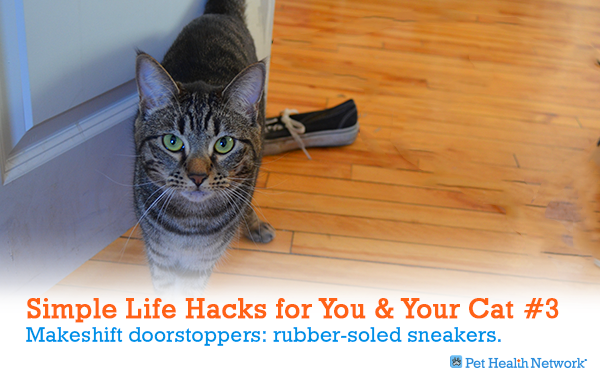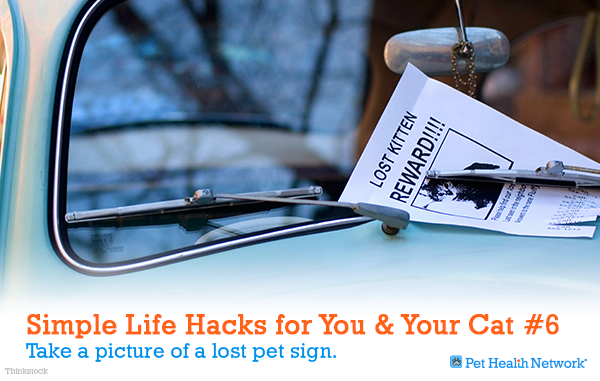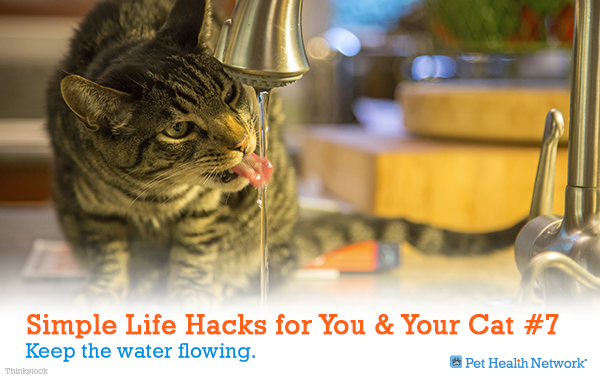1. Keeping cats off counters: the sticky (tape) solution
Cats are famously stubborn, but they can be trained. Training cats in a humane and positive way is fairly simple. Having trouble keeping your cats off surfaces and countertops? Try placing lines of tape, sticky-side-up, along the edges. This frequently suggested technique is a safe, humane way to stop your kitties from climbing up on places they're not supposed to go. Read more about keeping your cats off counters here>

2. Potted plants make bad litter boxes: The pine cone fix
Potted plants are a great addition to any house, but for some cats they’re also a popular choice when forgoing the litter box. If you’re having trouble keeping your cat from doing his business underneath your favorite fern, try covering the soil with a layer of pine cones. They’re decorative, they blend in, and your cats won’t have any interest in using them as a litter box. Read more about why cats miss the litterbox here>

3. Makeshift doorstoppers: rubber-soled sneakers
Behold, the power of a shoe.
There are all kinds of good reasons that you might want to keep your bedroom door mostly closed -- cracked enough that a feline can leave and reenter, but not hanging wide open for all the world to see. By placing a simple shoe about six inches from the slightly-open door, your cat can enter and leave freely -- without destroying the small shred of privacy you're trying to maintain.

4. Part-time pet parenting: foster the love
Having a pet isn't for everyone -- people who travel, people who work crazy hours, people who are at a point in their lives where their jobs or living situation is generally uncertain or unstable. But pets also provide stability, focus, a sense of responsibility and crucial companionship in good times as well as bad. Not sure you’re ready? Consider being a pet foster parent. Fostering cats won't be the best choice for everyone, but for the right households it can be a great joy. It's especially great for the cats, who would otherwise be housed in an animal shelter with dozens of other animals. Click here to learn more about being a foster parent>
Being a foster pet parent helps animals in many ways, beyond providing needed care and shelter. For example, when it comes to kittens and puppies, the foster home environment is better suited. Young animals, with immature immune systems, don’t’ always do well in the crowded and stressful setting of a shelter. In addition, being in a home environment and getting the love and attention of their foster families prepares them for their future homes and helps socialize them. The same is true for injured and ill animals. The extra love and care from their foster families helps promote a speedy recovery. As you can see, besides providing a needed lifeline for shelter animals, fostering prepares animals for their future families by exposing them to a loving setting.
Of course, there are those added responsibilities, too. If you do think fostering a pet might be right for you, Dr. MacPete recommends "contact[ing] your local shelters and local animal rescue groups. They will tell you what you need to do to become a foster parent and help you get started."

5. Help keep your pet safe: practice amateur pet photography
I did this for you, internet.
We never expect our cats to get lost or go missing, but it happens all the same. If you've only got a blurry, out-of-focus picture of your cat taken from a bad angle, those "missing" signs you put up around the neighborhood might not be much help to all the pet-loving good Samaritans out there hoping to spot your lost kitty. Clear, identifiable, up-to-date images of your cat will help show their current size, weight and other physical features that will hopefully lead to their safe return. So go ahead. Take more pictures of your kitties. And, come on, you might as well just post them on the internet (or Pet Health Network’s Facebook page. Just think of all the likes, upvotes and retweets that'll start rolling in! [Editor’s Note: Also consider microchipping your pet for maximum protection.]

6. Help find lost pets: snap a picture
In the digital age, we all carry around cameras in our pockets that can snap a practically-endless number of images. We use them for sharing memories with friends, for posterity and personal organizing or just for the potential future embarrassment of our kids and young relatives. So why not snap a quick photo of that sad "missing" poster on the street? Maybe you'll see a cat outside in the coming days, but you're not quite sure it's the same one that you saw on the poster. Or maybe you'll find the missing cat, only to realize you have absolutely no idea who to call. Either way, a quick photo on your phone of the cat's image and the owner's contact info could be the difference between restoring a cat and his owner and leaving the two searching for each other, unrequited and super sad. And let's face it, sad cats are basically the worst thing ever.

7. Keep it flowing: running water dishes
Cats who love drinking out of faucets, their owners' cups of water, the toilet or other undesirable places will love having a water fountain to call their own. Some have even been known to adorably play with the stream of cool, fresh water! And as Dr. Justine Lee has noted here, drinking more water can even help prevent feline urethral obstruction (FUO).

If you have any questions or concerns, you should always visit or call your veterinarian -- they are your best resource to ensure the health and well-being of your pets.
